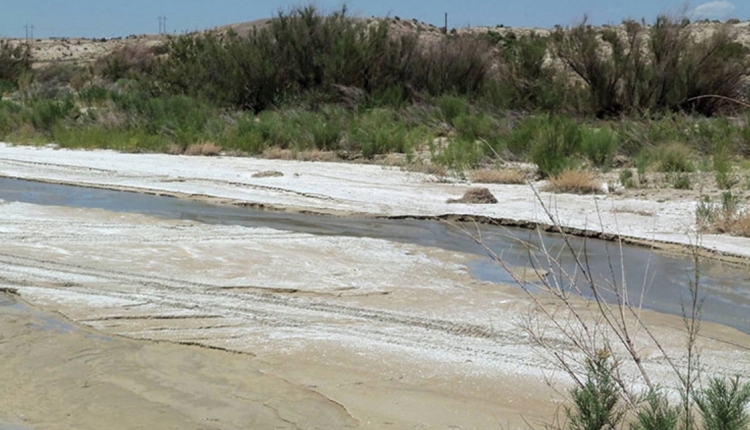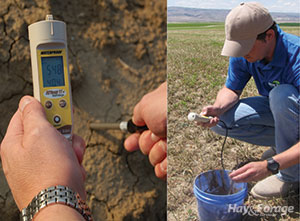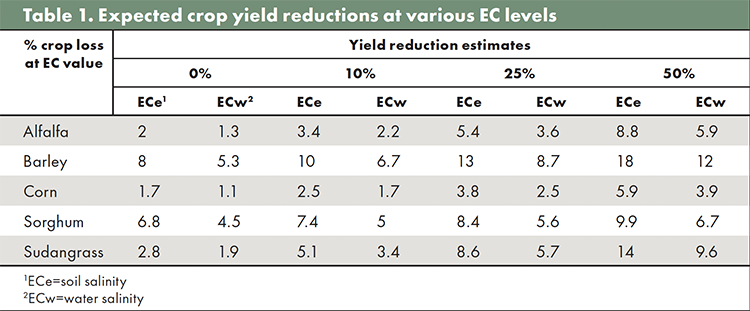The author is the director of product development for Alforex Seeds and has worked with Western alfalfa growers for nearly 40 years.

Alfalfa growers in the western U.S. are very aware of how important it is to have adequate irrigation water to produce a crop. In the distant past, irrigation water appeared to be unlimited and could be sourced from major rivers and/or pumped from underground aquifers. However, over time, the demand for water for agriculture and cities has become greater than the supply.
The lack of water is being exasperated by a severe multi-year drought that is reducing river flows and placing high demands on irrigation water from aquifers. With major reservoirs at historic lows, many regions are limiting the amount of surface water made available to produce crops like alfalfa. Many farms and ranches only receive a small fraction of their annual allotment of irrigation water from these reservoirs. The difference is often made up by pumping from underground aquifers. However, this practice is not sustainable in the long term and may become more regulated in the future.
With the potential reality of climate change and the possibility of more long-term droughts in the future, farmers are implementing water conservation practices and utilizing new technologies to efficiently apply the water they do have. Regions that historically used flood irrigation are moving to sprinklers and, in some cases, drip lines. These methods significantly reduce the water used to grow alfalfa during the growing season but tend to enhance soil salinity.
At some point, when rainfall or available irrigation water are not sufficient to leach accumulating soluble salts out of the root zone, salinity will interfere with normal crop growth and performance. The yield losses may be small at first, but if left unchecked, the salinity will worsen over time and eventually cause economic losses.
The rate of salinity buildup and amount is often more severe during periods of drought. Soil salinity is caused by two factors: 1. Water sources may become more saline during extended droughts, and 2. The ability to leach salts out of the soil profile is hampered by the lack of adequate water. The following is a brief overview of how drought and soil salinity interact along with possible management actions that can be taken.
A common salt source
One of the most common sources of soil salts is irrigation water. Most, if not all, irrigation water contains some level of salt. It has been said that over time, irrigation leads to the salinization of soil and water. As such, all irrigated land will eventually have to be managed for salt.
Rainwater is virtually free of salt; however, all water that contacts the soil will pick up salts, with the amount varying depending on the composition of the soil in each region.
River water at the source is relatively pure but will collect soluble salts as it moves downstream. In wet years, the large amounts of water in river flows can dilute the salt concentration; however, in times of drought, the amount of water in the normal stream flow declines, and there is less water to dilute the salt load.
Irrigation water taken from surface sources during droughts is generally more saline and will deposit more salt in the soil profile. It has been reported that the California aqueduct irrigation water deposits 700 pounds of salt for each acre foot of water applied. A full irrigation season deposits 1.2 tons of salt per acre. During drought periods, the salt load may be even higher.
There are some mitigation strategies that can be used to reduce salt levels in the soil. During good water years, farmers can take advantage of the lower river water saline content and use that irrigation water to leach soil salts out of the root zone.
In regions where farmers have access to both surface and subsurface water of varying salt content, the good quality water can be used to dilute the salt load by leaching more concentrated salts out of the root zone. This can be done by either alternating the good and bad water sources or, if possible, physically mixing the water sources during irrigation to dilute the overall salt content. Extreme drought conditions and lower stream flows may reduce the alfalfa grower’s access to lower saline irrigation water for this practice.
Aquifer stratification
In some aquifers, fresh water is perched over deeper, more saline water. This is because fresh water is less dense, having a specific gravity of 1, while saline water is more dense and has a specific gravity of 1.025. Excessive pumping during drought conditions to offset the lower surface water allocations may cause the deeper saline water in the aquifer to move upward and mix with the fresh water. This can raise the saline content of the irrigation water being pumped and lead to additional salt buildup in the soil profile.
Knowledge of which wells have the best quality water is important in managing soil salinity. Periodically, test each well’s salinity during the irrigation season, especially late in the season. Water from some wells may become more saline as the season progresses with larger amounts of water being pumped from the aquifer.
Before irrigation water became more limited, many regions used irrigation methods, such as flood irrigation, that applied large volumes of water. This method commonly applied 6 or more inches of water per irrigation, and as a result, there was plenty of water to leach accumulating salts out of the soil profile. However, as water became more limited, farmers started using other forms of irrigation to apply their limited water supply more efficiently. Over time, many farms converted from flood irrigation to various forms of sprinkler irrigation. Some areas have now embraced the recent technology of drip irrigation to produce alfalfa.
These water conservation practices offered the means of significantly reducing the amount of water used per irrigation but generally provided less water for leaching salts out of the soil profile. The following are a few of those methods and their limitations regarding salinity:
Circle pivots and sprinklers: Sprinkler systems often apply a lot less water per irrigation than flood irrigation. However, the wetting depth in the soil profile generally is only about 8 to 12 inches deep. Repeated irrigations with this reduced amount of water (2 to 4 inches) results in the accumulation of salts at the edge of the soil wetting front.
At the end of the season or during a seasonal wet period, it may be necessary to apply a heavy irrigation to leach salts out of root zone depending on the salinity buildup.
It’s advisable to periodically check the level and extent of the salt buildup in the soil profile under the sprinkler, particularly at the depth of the wetting zone front. This will help determine the extent of any salt buildup in the root zone.
Drip irrigation: With limited water and drought conditions, more drip irrigation is being used for alfalfa production, especially in California and Arizona. The efficiency of this irrigation method is that it only wets the soil closest to the plant roots. However, like sprinklers, salts can accumulate at the edge of wetting front and salt buildup can eventually be an issue.
When using drip irrigation, maintain enough water flow through drip lines to push salts accumulating at wetting front out of root zone. Monitor salt buildup in the soil profile and if salinity levels become excessive, it may be necessary to apply a heavier irrigation to push salts out of the active root zone. This can be done in wet years or between crops. Some farms utilize temporary sprinklers to provide extra water for this leaching process.
Alfalfa advancements

Developing drought tolerance in alfalfa is not as advanced as the breeding work for salinity. However, preliminary research appears to indicate that a salt tolerant variety’s ability to access water efficiency against a strong saline osmotic soil solution may provide some advantage in limited water situations when alfalfa is also exposed to drought conditions.
Routinely monitor your soil and irrigation water salinity. Alfalfa is somewhat tolerant to salinity; however, as the water salinity rises during a drought, there can be an associated yield loss due to salinity in soil or water salinity, which is often measured by electrical conductivity (ECe or ECw; see Table 1). There is a 7.5% yield loss in alfalfa for each soil ECe point above 2. Investing in a portable salt (EC) meter for $300 to $500 can make monitoring salinity a lot more convenient (see photo).

Another mitigation strategy is to eliminate poor producing fields and use additional water to leach salts out of the root zone in the highest producing fields.
Finally, plant salt tolerant alfalfa varieties where salinity is a recurring or growing issue. A list of these varieties can be found in the National Alfalfa & Forage Association’s Alfalfa Variety Ratings 2022 booklet at bit.ly/HFG-AVR22.
This article appeared in the January 2022 issue of Hay & Forage Grower on pages 10 & 11.
Not a subscriber? Click to get the print magazine.

